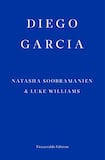
The winner of the 2022 Goldsmiths Prize, which lauds books that “break the mould” of the novel form, is a joint autofiction by Natasha Soobramanien and Luke Williams. Diego Garcia follows two writers grappling with how to tell the story of the Chagos Islands, an archipelago still at the mercy of colonialism.
Chagos was part of Mauritius, a British colony that gained independence in 1968. The UK used it as a bargaining chip, making Mauritian independence conditional on retaining the islands. They promptly proceeded to lease the largest island, Diego Garcia, to the US for use as a military base (called, of all things, ‘Camp Justice’). Some 1,500 Chagossians were forcibly expelled over the next five years. Despite rulings that the deal was not only illegal but “akin to a crime against humanity”, the UK has flouted calls from the UN to “bring to an end its administration ... as rapidly as possible.” (The case brought to The Hague is the subject of Philippe Sands’ recent nonfiction book, The Last Colony.)
[ Britain found to be illegally occupying Chagos IslandsOpens in new window ]
Diego Garcia opens in Edinburgh in 2014. Damaris, who is British-Mauritian, and Oliver Pablo, a Scot, live together, having left London after the suicide of Oliver’s brother. Damaris does the odd teaching gig and is deep in debt; Oliver trades bitcoin. They spend their days trying to get to the library to write and bickering over money.
A shared language reinforces the pair’s platonic intimacy: cigarettes are “tubes”; books are “blocks”; even Creole is rendered as “Kreol”. They have their own moral code, stealing books from chains and “exchanging” them for better books of the same price point in indies. The first-person plural is used alongside the third-person singular, sometimes within the same sentence: “The first time we met she said, I hope you’ve brought money and he said, I have.” When the two friends are apart, the page splits into parallel columns to represent their separate consciousnesses.
Sally Rooney: ‘I enjoy writing about men ... the dangerous charisma of the oppressor class’
Alzheimer’s: ‘I’ve lost my friend and my companion,’ says Úna Crawford O’Brien of fellow Fair City actor Bryan Murray
Ryan Adams at Vicar Street: A gig that nobody will forget anytime soon, but perhaps not for all the right reasons
Meghan Markle’s new podcast: An ego-fluffing conversation underlining the culture gap between Ireland and the US
Damaris and Oliver become interested in Chagos after meeting a poet and child of the diaspora who calls himself Diego Garcia. When Diego disappears, they worry that he has fallen victim to sagren, a Creole word for heartbreak from the French chagrin (which carries a more sorrowful connotation than the English chagrin), a common affliction in the uprooted.
Damaris writes a short story about Diego as told by his sister Rose, which forms the second section of the novel, set apart by font and prose style. It intertwines Diego’s life with that of Oliver’s brother, a video artist who took his own life after discharging himself from a psychiatric ward. The piece causes a rift with Oliver that leads them to part ways. “It’s just a story,” she defends herself. “Yes, but not yours,” he retorts.
It’s this question of appropriation that lies at the heart of the book: “how as a writer do you tell a story that needs to be shared, if it is not your story?” Damaris believes that writers should not have “unimpeded extractive rights to the world’s narrative resources”, bringing to mind the backlash against novels such as Jeanine Cummins’ 2020 best-seller about Mexican migrants, American Dirt. But what does “a fiction of solidarity” look like?
The book is first joint effort to win the Goldsmiths Prize, and “collaboration is both method and politics” for the authors, noted Tim Parnell, chair of judges. Soobramanien previously wrote two chapters of Williams’s 2011 novel The Echo Chamber, a process described in Diego Garcia (including concerns that the contribution disqualified entry from most prizes). The authors’ collaboration reaches beyond their dyad: as Damaris and Oliver research the history of Chagos, factual fragments, including lengthy extracts from articles, legal documents, books and documentary films, are woven into the text, and their conversations often cite authors and philosophers.
[ UK suffers huge defeat in UN vote on Chagos IslandsOpens in new window ]
As the Chagossians strive to reclaim an identity, Damaris and Oliver are continually trying to erase themselves in their writing. They are intrigued by forms that channel other voices, such as translation and writing by écrivains publiques – originally scribes for the illiterate, now those who liaise with bureaucracies on behalf of immigrants. Having first fantasised about writing a book that would “[deal a blow] to the military-industrial complex”, “I’m more interested in other people’s writing than in my own,” Damaris writes towards the end. “I want to be a different sort of writer now.”
The third part of Diego Garcia is an epistolary email exchange between Damaris and Oliver in 2020 and 2021 (seemingly leading to the book in our hands). While it’s less interesting stylistically than their split consciousnesses, the fragments nonetheless add up to a whole greater than the sum of the parts.
The project may even have succeeded in its social aims. On November 3rd, the UK finally agreed to negotiate with Mauritius over the handover of the Chagos Islands, aiming to reach a settlement early next year. The government cited interests in building alliances in the Indo-Pacific as the cause of the U-turn, but might two compelling books on the plight of the Chagossians out this year have contributed to the change of heart?















